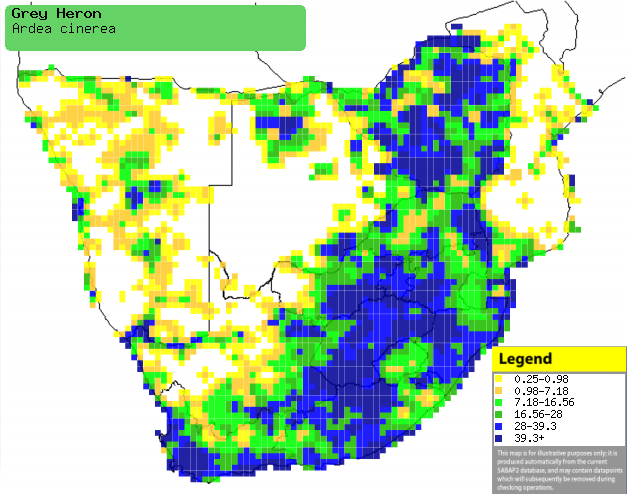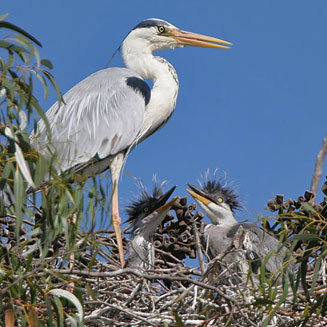Ardea cinerea (Grey heron)
Bloureier [Afrikaans]; Isikhwalimanzi ,
Ukhwalimanzi (terms also applied to Black-headed heron) [Xhosa];
uNokilonki (also applied to Black-headed heron) [Zulu]; Samunkoma
(also applied to other long-neck egrets and herons) [Kwangali];
Kokolofitoe -putsoa [South Sotho]; Kôkôlôhutwê [Tswana]; Blauwe
reiger [Dutch]; Héron cendré [French]; Graureiher [German]; Garça-real
[Portuguese]
Life
> Eukaryotes >
Opisthokonta
> Metazoa (animals) >
Bilateria >
Deuterostomia > Chordata >
Craniata > Vertebrata (vertebrates) > Gnathostomata (jawed
vertebrates) > Teleostomi (teleost fish) > Osteichthyes (bony fish) > Class:
Sarcopterygii (lobe-finned
fish) > Stegocephalia (terrestrial
vertebrates) > Tetrapoda
(four-legged vertebrates) > Reptiliomorpha > Amniota >
Reptilia (reptiles) >
Romeriida > Diapsida > Archosauromorpha > Archosauria >
Dinosauria
(dinosaurs) > Saurischia > Theropoda (bipedal predatory dinosaurs) >
Coelurosauria > Maniraptora > Aves (birds) > Order:
Ciconiiformes
> Family: Ardeidae
Distribution and habitat
Occurs across much of the Old World, from western
Scandinavia, Britain and the Iberian Peninsula to sub-Saharan Africa. In
southern Africa it is most abundant
in Zimbabwe, northern and eastern Botswana and South Africa, while also
occupying patches of Namibia and Mozambique. It generally favours shallow water
bodies, such as estuaries, lagoons, rivers, lakes, the intertidal zone, marshes
and dams.
|
 |
|
Distribution of Grey heron in southern Africa,
based on statistical smoothing of the records from first SA Bird Atlas
Project (©
Animal Demography unit, University of
Cape Town; smoothing by Birgit Erni and Francesca Little). Colours range
from dark blue (most common) through to yellow (least common).
See here for the latest distribution
from the SABAP2. |
Movements and migrations
Migratory north of the equator, but resident in
southern Africa, occasionally moving in response to changes in
habitat.
Food
It mainly eats fish, using three different hunting
techniques: it can wait at one spot for prey to come within striking distance;
it can walk carefully
through shallow water before ambushing prey, or it just drops into the water from the
air. Once it catches something, it manipulates the first to a head-first position before
swallowing it, as seen in the photos below. The following food items have been recorded
in its diet:
- Vertebrates
- fish
- Mugil (mullet)
- Tilapia (tilapia)
- Serranochromis (largemouths)
- Clarias (catfish)
- eels
- amphibians
- reptiles
- small rodents
- small birds
- Invertebrates
- molluscs
- crustaceans
- worms
- insects
Breeding
- Monogamous and usually colonial, often breeding in mixed-species colonies,
although it may also nest alone or in small groups. The male performs many
different types of displays, including one in which it calls from a
prominent perch before throwing its head upward and giving a loud yelp.
- The nest (see image below) is mainly built by the female over the course
of several days, consisting of a platform of large sticks with a central
basin of reeds, lined with grass and other soft material. Sometimes, a new
nest is built on top of an old one which transforms it into a massive
structure. It is typically placed in a tree fork or bush, 1.5-2.0 metres
above water in a reedbed, or rarely on a cliff ledge or on the ground of a
small island.
 |
|
| Grey heron at nest with chicks, West Coast
National Park, South Africa. [photo Trevor Hardaker ©] |
|
- Egg-laying season is year-round, peaking from July-January.
- It lays 1-4 eggs, which are incubated by both sexes for about 23-28
days.
- The oldest chick is treated the best, as the younger siblings are often
malnourished, in fact the youngest almost invariably dies before fledging.
The chicks are brooded by both parents for roughly 18 days, and are still guarded
24/7 for another 11-12 days. They leave the nest at about 50 days old, becoming fully
independent 10-20 days later.
Threats
Not threatened, in fact it has greatly benefited from the
construction of artificial water bodies.
References
-
Hockey PAR, Dean WRJ and Ryan PG 2005. Roberts
- Birds of southern Africa, VIIth ed. The Trustees of the John Voelcker
Bird Book Fund, Cape Town.
|
